The Importance of Temperature Monitoring for Restaurant Operations
If you’re looking for a cloud-based temperature monitoring solution that eliminates manual logging, improves compliance readiness and monitor food quality and safety standards, you’ve arrived at the right place.

Let us help you evaluate your needs!
- Safety: Alerts via text, email, push notifications and phone calls to protect your precious assets
- Compliance: Automated compliance reports
- Efficiency: Reduced Manual Logging and time spent on reports
And what makes us different?
- Lifetime Warranty: Never buy hardware again!
- Unlimited Users: Scale across your entire organization
- Connectivity Flexibility: Wi-Fi, Cellular or Data Hub
- Phone call alarms: Alerts won't get ignored
- Mobile App: 500 Freezers in your pocket
- Facility monitoring: Simple to add water leak, door open, occupancy, and even IAQ monitoring
Engineered in Indiana with U.S.-based support.
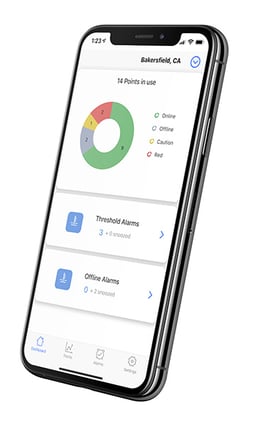
See What Customers Say About Sonicu
Asset Protection. Compliance Automation. And Reduced Manual Processes.
Sonicu serves thousands of professionals at hundreds of organizations across North America by improving how they monitor and manage their most sensitive assets and environments.
Professionals from healthcare, life science, laboratory and cold chain facility management turn to Sonicu to help them improve the way they do business.
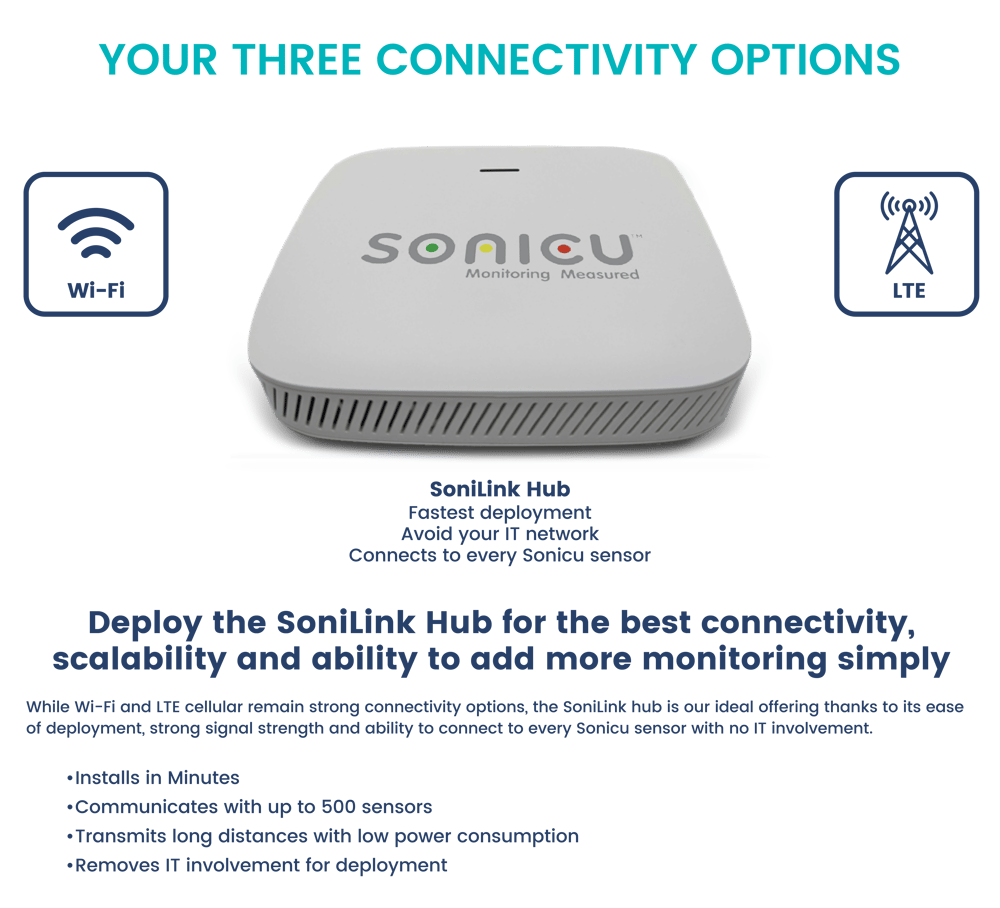
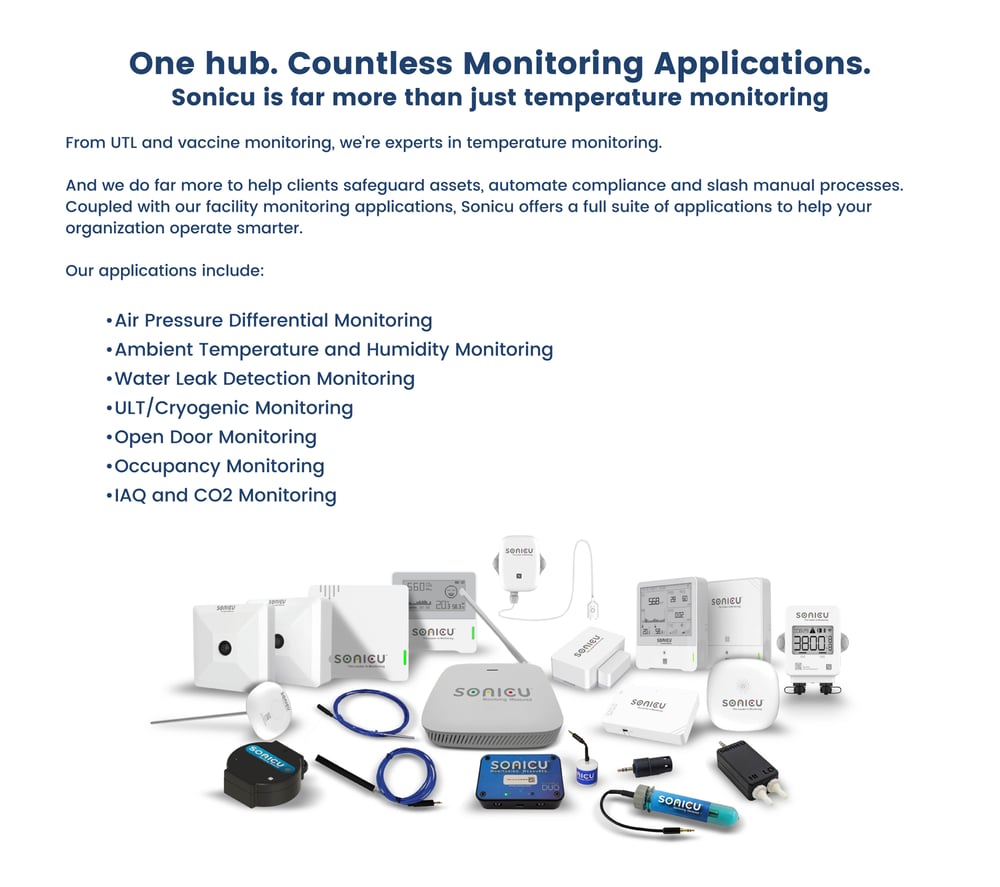
The Importance of Temperature Monitoring for Restaurant Operations
The restaurant industry is a highly competitive and dynamic sector to get into. Besides competing with many food services and following the trends, you must ensure that everything you serve is one-of-a-kind and safe.
And with people becoming more aware of food quality and safety standards, there's no room for restaurant owners to make errors. Thus, they must create ways to stand out while complying with those regulations.
Temperature monitoring is one way to help your restaurant strive.
If you're wondering how that is, this blog will explain why it's essential for restaurant operations.
Read on to learn more.
What is Temperature Monitoring?
From the word itself, temperature monitoring means monitoring the temperatures in a given environment.
It's typically practiced in industrial and medical settings to record and control temperatures in various areas, such as refrigerators, freezers, storage rooms, manufacturing environments, and medical laboratories.
In a restaurant setting, a temperature monitoring system can be used to keep food and HVAC at an ideal temperature.
The digital temperature sensors can detect and record temperatures, which are then sent to a computer or other device for monitoring and analysis.
Sonicu has built a remote wireless temperature monitoring system trusted by hundreds of healthcare and life science organizations as well as scores of food service organizations.
As restaurants, delis, and breweries improve their operations and hedge against rising food prices, more leaders are discovering how simple and affordable it can be to install a wireless temperature monitoring system like Sonicu.
You can learn more about how our software helps compliance professionals in these case studies:
Discount Drug Mart: Power Outage Protection + Compliance Automation
Problem: Transitioning from manual temperature logs to reactive power outage management
Solution: Adopting Sonicu's advanced system for seamless temperature monitoring and real-time power outage alerts across its 77 locations.
Hendricks Health: From Nutrition to the OR
Problem: The need to improve compliance and safety across various departments, starting from nutrition to the operating rooms.
Solution: Upgraded monitoring systems to enhance patient safety and streamline compliance across multiple facilities, including local YMCA rehabilitation facilities.
IU Health: Enterprise Monitoring
Problem: Challenges of using a locally based server and multiple monitoring solutions across departments.
Solution: Transitioned to a single, cloud-based solution with Sonicu to enhance monitoring capabilities across more than a dozen locations and the IU School of Medicine.
This installation video shows how easy it can be
Why is Temperature Monitoring Essential?
There are many reasons why temperature monitoring is vital in restaurants.
Here are a few of them:
Ensure Food Safety
According to the World Health Organization, every year there are an estimated 600 million or almost 1 in 10 people in the world who get sick because of food contamination, and 420,000 of them die.
Thus, the Food and Drug Administration (FDA) enacted the Food Safety Modernization Act (FSMA) to get a more proactive approach to foodborne illnesses.
But how is this related to food temperature?
Even though we cannot see bacteria with our naked eyes, they are present in everything we consume.
However, the possibility of a person falling ill depends on the type of bacteria or the amount we consume. Unfortunately, pathogenic bacteria grow on food if it's not held at an appropriate temperature, which increases the risks of foodborne illnesses.
When the food temperature is between 40-140 degrees Fahrenheit or the danger zone, bacteria multiply quickly—and can double their number in just 20 minutes.
Thus, by continuously monitoring food temperature, whether you're storing, preparing, or cooking it, you can avoid the danger zone and provide the safest dish possible to your customers.
Maintain Food Quality
We want to make sure that all the food we serve is as tasty as possible.
And given that bacteria can grow in the danger zone, we must keep the food at the proper temperature at every stage—from storing to cooking. Doing this can help maintain the food's natural flavor, smell, and texture that food enthusiasts look forward to tasting.
With so many options on where to eat, restaurant leaders are always looking for ways to ensure quality and taste to keep their loyal customers coming back.
Minimize Food Waste
Food waste has been a great contributor to the climate crisis we have today.
In the United States alone, 160 billion pounds of food is wasted every year, which is also about 35% of our food supply.
With that alarming data, it's crucial for restaurant owners to minimize their food waste and take part in the environmental initiative.
One way to do that is by keeping the perishable goods at the correct temperature.
Because as you know, if the temperature of the food is too low or too high, the food can spoil quickly and be rendered unsafe to consume.
By monitoring and controlling the food temperature to a desirable condition, you can extend its shelf life, avoid food spoilage, and cut back on food waste.
Temperature monitoring like Sonicu is simple and affordable and can make a significant impact on the ability of restaurants to combat food waste by alerting you and your staff when a temperature excursion threatens your food supply.
Improve Work Safety
In a restaurant setting, it's inevitable for food production workers to be exposed to high temperatures from stoves, grills, and ovens.
And this can result in various heat injuries that could affect their health and productivity at work.
A great way to approach this is by managing temperatures in working spaces using temperature monitoring equipment.
Besides avoiding heat exhaustion and other health risks, it can also prevent fire hazards and identify areas prone to allergens.
By monitoring temperature, you can reduce heat injury at work and ensure that your workers are in a safe and comfortable environment.
Save Energy Costs
Another benefit of temperature monitoring is that it can help you save money on electricity.
You can be able to track your energy usage and adjust your systems accordingly by proactively monitoring temperatures.
It allows you to identify equipment that consumes more energy than necessary and make adjustments to reduce your energy usage.
In addition, temperature monitoring can help you identify faulty equipment and HVAC systems that can't keep the temperature at an optimum level.
Keep in mind that if you just leave them be, it will cost you more in the long run than getting them repaired or replaced early.
Temperature monitoring can help fight high energy costs in a restaurant in the following ways:
- Energy Efficient Equipment: Temperature monitoring can help identify areas where energy-efficient equipment can be installed. For example, by monitoring the temperature of refrigerators, freezers, and other cooling equipment, restaurant owners can identify equipment that is not functioning efficiently and needs to be replaced or repaired.
- Preventing Equipment Overuse: Monitoring temperatures can also help prevent equipment overuse, which can lead to higher energy costs. By ensuring that equipment is operating at the proper temperature, restaurant owners can prevent equipment from running longer than necessary and consuming more energy than needed.
- Improving Workflow: Proper temperature monitoring can also help improve workflow in a restaurant. By monitoring the temperature of food items during cooking and holding, restaurant staff can better manage food production, reducing the need to prepare food in advance and keeping energy usage to a minimum.
- Preventing Waste: Temperature monitoring can help prevent food waste, which can also contribute to higher energy costs. By ensuring that food is stored at the proper temperature and not left out for too long, restaurant owners can prevent food from spoiling and needing to be discarded.
You can learn more about how our software helps compliance professionals in these case studies:
Hancock Regional Health: Enterprise Monitoring from Sound to Environmental
Problem: Disparate monitoring systems were taxing the staff with many manual processes, leading to inefficiencies and reduced asset protection.
Solution: CEO Steve Long initiated the adoption of a consolidated monitoring program for temperature, environmental, and sound, which automated compliance and reduced manual logging.
Xytex Sperm Bank: Ultra Low Temperature Monitoring
Problem: Frequent false alerts were causing alarm fatigue, threatening the operations at Xytex Sperm Bank.
Solution: Partnered with Sonicu to develop a custom temperature monitoring solution for ULT and cryo temperatures, including probes inside and outside the preservation chambers.
Boy Scouts: Protecting Campers from a Temperamental Walk-in Cooler
Problem: An aging walk-in cooler failed at a remote campground in Ohio, causing significant food loss and logistical challenges for the Boy Scouts.
Solution: Sonicu provided a system that was easy to install, connected with a mobile app, affordable for a non-profit budget, and automated the required manual logging.
Comply With The Laws
Finally, temperature monitoring can help you meet regulations regarding food safety and work environment safety.
It can ensure that the products you sell meet industry standards and any relevant health and safety regulations. Sonicu has a simple reporting engine that allows users to access temperature logs over any period, that can easily satisfy virtually any regulator.
Additionally, it can prevent heat hazards to workers' health that could be a hit to OSHA compliance.
The specific agencies that audit restaurants for health and safety can vary depending on the location of the restaurant.
However, in the United States, the most common agency responsible for restaurant health and safety inspections is the local health department.
These departments are usually part of a city or county government and are responsible for ensuring that restaurants comply with local health codes and regulations. In addition to the health department, other agencies, such as the Department of Agriculture, Food and Drug Administration (FDA), or the Occupational Safety and Health Administration (OSHA) may also conduct audits or inspections of restaurants for health and safety.
It's essential for restaurant owners to be aware of the local agencies that oversee their operations and comply with all regulations to maintain the safety of their customers and staff.
The Bottom Line
Temperature monitoring is very crucial in restaurants.
It can help with food safety, maintaining food quality, reducing food waste, improving work safety, saving energy costs, and meeting industry and government regulations.
- Food Safety: Keeping food at the proper temperature is essential for preventing the growth of harmful bacteria that can cause foodborne illnesses. Temperature monitoring helps ensure that food is stored, cooked, and served at safe temperatures.
- Quality Control: Proper temperature monitoring also helps maintain the quality of food. For example, cooking food at the correct temperature ensures that it is cooked evenly and doesn't become overcooked or dry. Holding food at the right temperature also ensures that it doesn't become soggy or lose its texture.
- Compliance: Many local and national regulations require restaurants to monitor and document temperature readings for food safety purposes. By keeping accurate records of temperature readings, restaurant owners can demonstrate compliance with these regulations and avoid potential fines or legal issues
- Customer Satisfaction: Finally, temperature monitoring is essential for customer satisfaction. Nobody wants to eat food that is too cold or too hot, and customers are likely to be unhappy if they receive food that is not at the right temperature. By ensuring that food is served at the proper temperature, restaurants can improve customer satisfaction and encourage repeat business.
If you're wondering where to get the best temperature monitoring system available, visit Sonicu now!
American-based Customer Support: Robust & Reliable High Touch Service
Software and technology is only as good as the people who stand behind it.
At Sonicu, that means our team of American-based customer success managers who are never more than a phone call away to help field and fix any service issues.
Our probes and sensors are placed in demanding frozen environments and our software literally sends billions bits of data monthly, meaning there’s always the potential for a hiccup on either the hardware or software.
We are committed to fielding every customer service request promptly and addressing our customer’s concerns promptly and professionally.
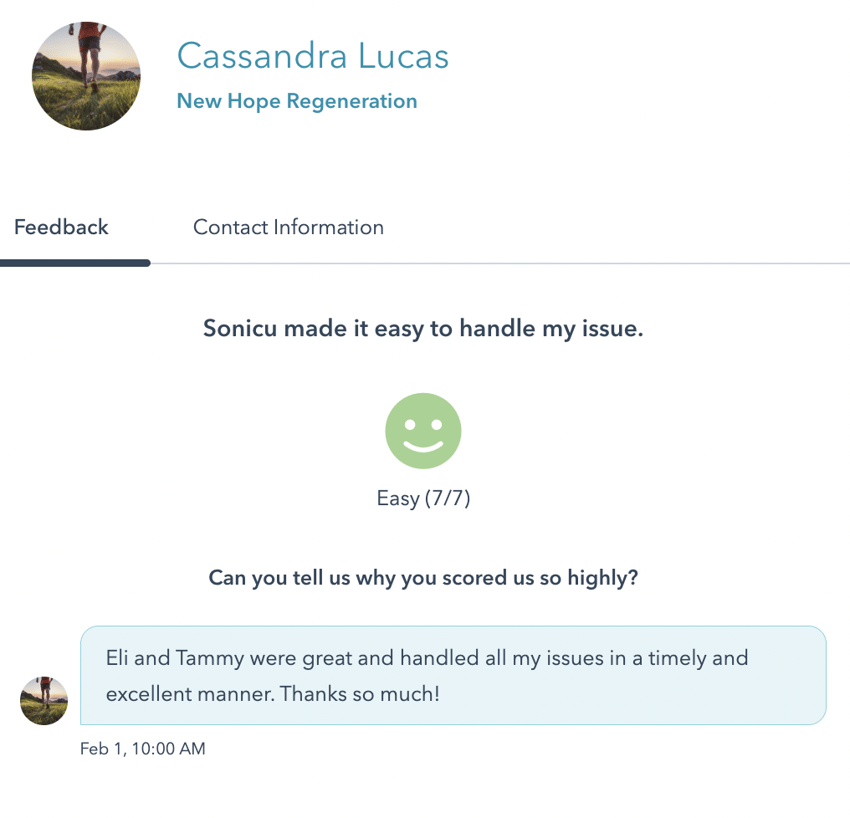
 “I like to say that every refrigerator or freezer is like a car in that they all behave a bit differently,
“I like to say that every refrigerator or freezer is like a car in that they all behave a bit differently,
and then every now and then you just get a bad boy who doesn’t want to perform as we need it to,”
Martha Rardin, Director, Nutrition and Dietetics, Hendricks Regional Hospital.
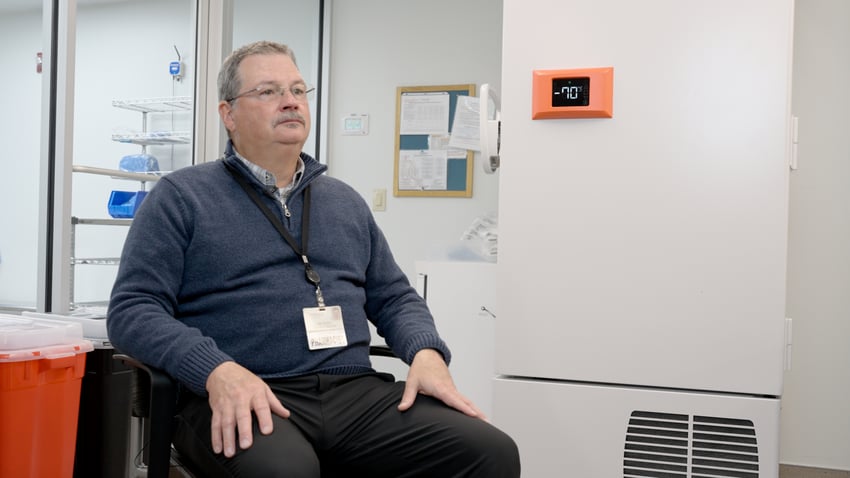 “Sonicu has been a powerful tool to identify which units are behaving out of spec and get our team
“Sonicu has been a powerful tool to identify which units are behaving out of spec and get our team
to fix them before we have a serious issue.”
Tim Livesay, Director, Hancock Regional Hospital Pharmacy Director


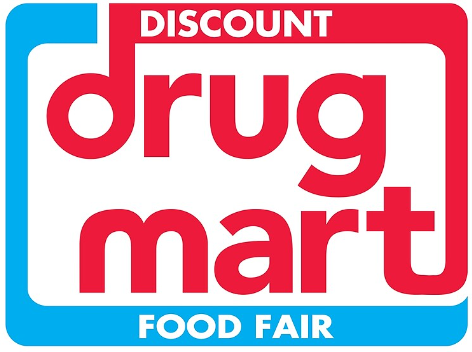
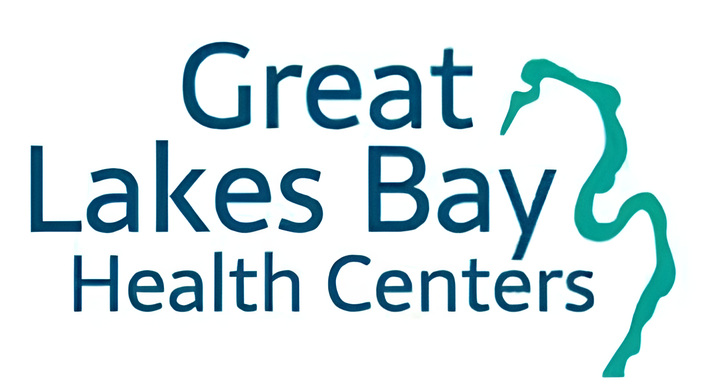

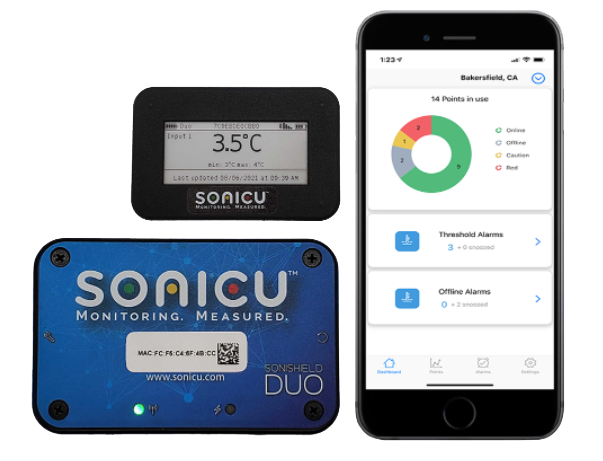
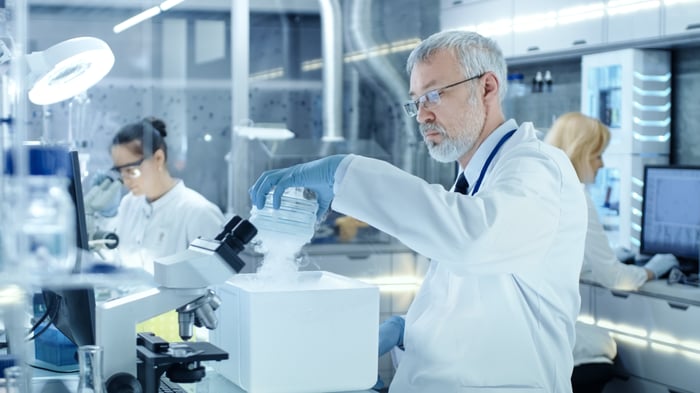


How IU Health
consolidated all of its pharmacy monitoring needs
into one cloud-based platform serving dozen of locations.